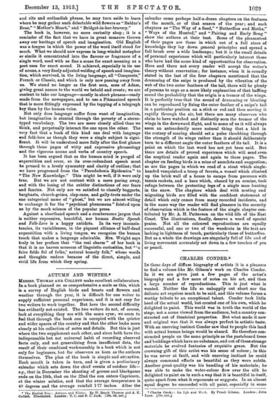CHARLES CONDER."
IN these days of diffuse biography of artists it is a pleasure to find a volume like Mr. Gibson's work on Charles Conder. In it we are given just a few pages of the artist's biography and a few more of notes on his art, and then a large number of reproductions. This is just what is wanted. Neither the life so unhappily cut short nor the delicate art requires much to be said, and this volume forms a worthy tribute to an exceptional talent. Conder took little heed of the actual world, but created one of his own, which he delighted to paint. This world was in truth the world of the stage, not a scene viewed from the audience, but a country con- structed out of theatrical properties. But what made it new and original was that it was always perfect in artistic taste. With an unerring instinct Conder saw that to people this land with actual human beings would be absurd. He therefore con- structed people on the same principle as the pasteboard trees and buildings which have no substance, and out of these strange materials he evolved fantasies of exquisite grace. Bnt the crowning gift of this artist was his sense of colour ; in this be was never at fault, and with unerring instinct he could always command effects as beautiful as they were subtle. Another great quality was his handling of his materials; he was able to make the water-colour flow over the silk he delighted to paint on in such away that it is beautiful in itself, quite apart from what it represents or suggests. In an almost equal degree he succeeded with oil paint, especially in some
* Charles Condcr: his Ltfs and Work. By Freak Gibson. Loudon : John Lane. [21s. net.]
renderings of calm seas with delicate skies, which became things of beauty. Conder was akin to Beardsley, inasmuch as be too delighted in the purely artificial, but Conder had not the satanic quality of the black-and-white artist, even though he shared with him the same hectic outlook, the same love of decadence and of the iridescence of decay ; no doubt in both cases this was partly a result of ill-health. It is early to talk of immortality, but if Conder lives it will be in virtue of his gifts as a colourist, for here there can be no two opinions as to his success. To complete this volume Mr. Campbell Dodgson, the keeper of the prints and drawings at the British Museum, has added a catalogue of Conder's lithographs and etchings. We cannot help thinking that Mr. Gibson was most singularly ill-advised in admitting three-colour process reproductions into this book. The tender, elusive harmonies appear, of course, only in vulgar travesty.



























































 Previous page
Previous page